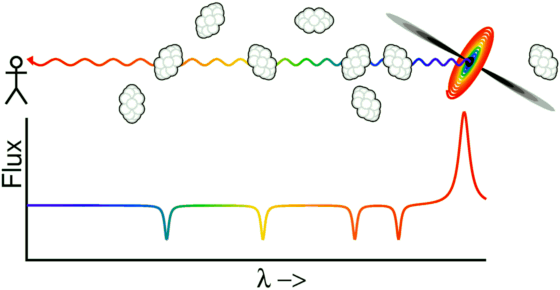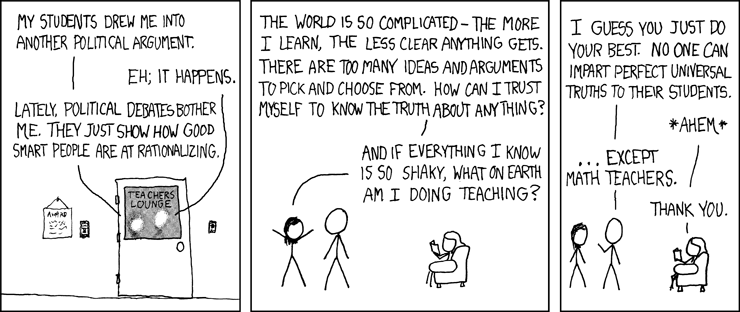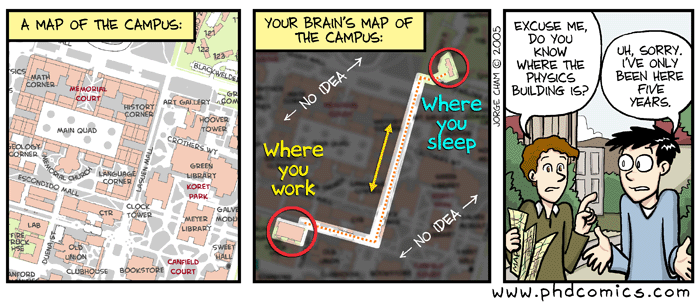It seems that I am now working on the Lyman-α forest, a fair cry from stars or the Milky Way. One of the great aspects of working on the Lyman-α forest is that it relates to so many other aspects of astronomy. And, recently, it's been difficult to spend much time here and not become interested in the composition and geometry of the IGM (e.g., this and this and this).
I had heard about the Lyman-α forest for quite a while before truly understanding what it is; in this particular case, it was a picture that made all the difference.
 For example, this cartoon, shamelessly borrowed from Ned Wright's page explaining the Lyman-α forest. There are three separate pieces needed to explain what is meant by the "Lyman-α forest, " or what is commonly written as the Lyα forest. First, there's the Lyman-α bit, which involves a bit about atoms and rudimentary atomic physics. Then, there's the large reservoir of gas between galaxies creatively known as the intergalactic medium, or IGM. Finally, there are the notions of redshift and thermal broadening and other fun things that can happen to change the wavelength at which a photon of light is observed.
For example, this cartoon, shamelessly borrowed from Ned Wright's page explaining the Lyman-α forest. There are three separate pieces needed to explain what is meant by the "Lyman-α forest, " or what is commonly written as the Lyα forest. First, there's the Lyman-α bit, which involves a bit about atoms and rudimentary atomic physics. Then, there's the large reservoir of gas between galaxies creatively known as the intergalactic medium, or IGM. Finally, there are the notions of redshift and thermal broadening and other fun things that can happen to change the wavelength at which a photon of light is observed.
Atoms and energy levels: As you should recall from your high school chemistry class (or as wikipedia [or here] would remind you if you were asleep that year), atoms come equipped with energy levels, and the electrons can move between the different levels. These transitions have different names, and the Lyman-α transition is the one between the n=1 and n=2 states. (Lyman-β is n=3 to n=1, Lyman-γ is 4 to 1, Lyman-δ is 5 to 1, and so on. The series of transitions into n=other states are have different names; the Lyman series is just the one named after some dude named Lyman.)
When electrons move from a higher energy level to a lower one, a photon (or two if it's a super-duper-forbidden transition) is emitted by the atom in order to conserve energy. Because the photon is carrying away the energy the atom had when it was in the excited state (i.e., when the electron was in the higher energy level), the energy the photon has is exactly equal to the energy difference between the two levels. So, when one counts the number of photons as a function of energy of some source—this is called taking a spectrum—there are certain wavelengths at which there are lots and lots of photons because lots of atoms have undergone energy transitions and emitted photons with near-identical energies. These are called emission lines.
Of course, the same thing can happen the other direction. If a photon of just the right energy encounters an atom, the atom can absorb the photon, essentially moving the electron from a lower energy level to a higher one. So if we take a spectrum of some bright source, we will see regions where a bunch of atoms have absorbed a bunch of photons all of one wavelength. These regions are known as absorption lines/features/troughs/whathaveyou.
The Intergalactic Medium (IGM): Hydrogen is by far the most common element in the universe; roughly 75% of all atoms in the universe are hydrogen atoms. Nowadays, most of the hydrogen is ionized, so instead of a proton and an electron hanging out together, they are separate. For electrons to be able to move between energy levels, it has to be associated with some nucleus, i.e., the atom has to be neutral. Even though the vast majority of hydrogen atoms in the IGM are ionized, there is enough neutral hydrogen around that Lyman-α (and other) transitions can trace the structure of the IGM. Of course, there are lots of other elements in the IGM, but we can only observe those with atomic transitions in convenient wavelength ranges; commonly observed other species are singly-ionized magnesium (MgII in spectroscopy lingo) and triply-ionized carbon (CIV).
As it turns out, the cartoon description above of the IGM as a bunch of isolated clumps of gas is wrong. A more accurate model has the gas distributed much more smoothly; the gas isn't perfectly uniform, and there are regions of low density and of high density, but the contrast between these regions is not large enough to think of the high density regions as "clouds."
Redshift, etc: The real key to being able to use absorption features to study the IGM is redshift. If we observed all of the intergalactic gas to absorb light at one wavelength, then it would be next to impossible to decipher any physical structure from a spectrum. Luckily, though, we live in an expanding universe, and so light travelling across long distances is redshifted, that is, the wavelength of a single photon gets longer as it propogates. (This is a redshift since longer wavelength means redder light.) The amount by which light is redshifted depends on the distance the light has travelled; this so-called cosmological redshift is the main thing for which Edwin Hubble is famous for figuring out. So, to return the the cartoon above, if we have some really bright faraway source, like a quasar or a gamma ray burst, then light coming towards us from this source will be redshifted. Specifically, light that was originally bluer than that of the Lyα transition will be redshifted to this wavelength, and if there is some neutral hydrogen sitting around where this happens, then it will be able to absorb that light. The more neutral hydrogen (i.e., the higher the neutral hydrogen density) at a given location, then the more Lyα light that will be absorbed. There is a lot of hydrogen in the universe, and the universe is really big, so spectra wind up looking more like this than the above cartoon:
 The big peak on the right is due to Lyα emission from the quasar itself, and all the mess to the left (bluewards) of that is the Lyα forest. Lots and lots of absorption.
The big peak on the right is due to Lyα emission from the quasar itself, and all the mess to the left (bluewards) of that is the Lyα forest. Lots and lots of absorption.
If this was the end of the story, then it would be fairly easy to go from a map of absorbed light to a density map of the IGM along some line of sight. Alas, this is astronomy, so there are lots of extra things going on. The first is that the gas in the IGM isn't perfectly cold; it has some temperature and so the atoms are moving around relative to one another, which causes individual lines to be smeared out. Observationally, this isn't all bad: we astronomers like knowing about temperatures as well as densities—and the relationship between the two.
As I mentioned earlier, astronomers now know that the IGM does not consist of discrete clouds floating around in a vast emptiness; the gas density instead fluctuates about some constant value. Part of what I am working on now is to try to determine what sets the scale of these fluctuations, or, equivalently, what sets the scale on which the IGM and the Lyα forest are smooth.











